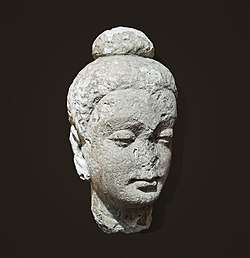Ushnisha

| Part of a series on |
| Buddhism |
|---|
 |
|
The ushnisha (Sanskrit: उष्णीष, IAST: uṣṇīṣa) is a three-dimensional oval at the top of the head of the Buddha.
Description
The ushnisha was not described initially in the Physical characteristics of the Buddha spelled out by the Buddhist canon. Rather, there are several mentions about a topknot:
- "His topknot is like a crown." (Secondary characteristics, No 53)
- "He has a topknot as if crowned with a flower garland." (Secondary characteristics, No 80)
Representation
The first representations of the Buddha in the 1st century CE in the Greco-Buddhist art of Gandhara also represent him with a topknot, rather than just a cranial knob. It is thought that the interpretation of the ushnisha as a supernatural cranial protuberance happened at a later date, as the representation of the topknot became more symbolic and its original meaning was lost.[1]
The Boddhisattva-Cakravartin in Early Buddhism
In Early Buddhism, the uṣṇīṣa was represented differently. The Mahāvastu (1.259f) and the Divyāvadāna, as well as the Theravadin Milindapañha, describe the marks of the cakravartin, an idealised world-ruler: uṣṇīṣa or patka turban, chhatra parasol, "horn jewel" or vajra, whisk and sandals. These were the marks of the kshatriya.[2]
The plastic art of early Mahayana Buddhism in Mathura presents bodhisattvas in a form called uṣṇīṣin "wearing a turban/hair binding", wielding the mudras for "nonviolent cakravartin rule".[2]